谚语翻译
英语谚语带翻译30条
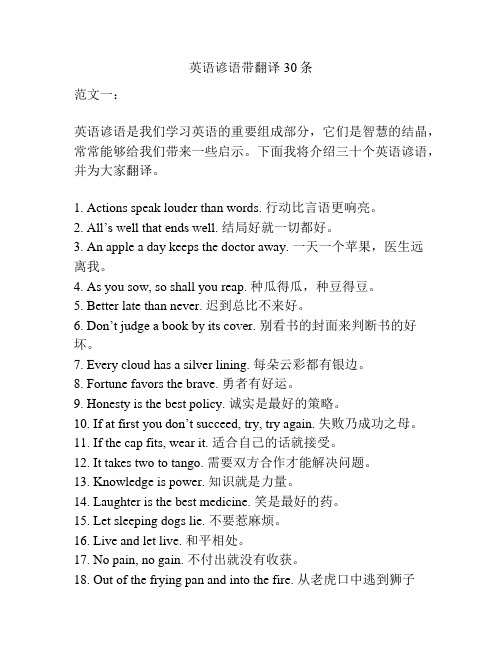
英语谚语带翻译30条范文一:英语谚语是我们学习英语的重要组成部分,它们是智慧的结晶,常常能够给我们带来一些启示。
下面我将介绍三十个英语谚语,并为大家翻译。
1. Actions speak louder than words. 行动比言语更响亮。
2. All’s well that ends well. 结局好就一切都好。
3. An apple a day keeps the doctor away. 一天一个苹果,医生远离我。
4. As you sow, so shall you reap. 种瓜得瓜,种豆得豆。
5. Better late than never. 迟到总比不来好。
6. Don’t judge a book by its cover. 别看书的封面来判断书的好坏。
7. Every cloud has a silver lining. 每朵云彩都有银边。
8. Fortune favors the brave. 勇者有好运。
9. Honesty is the best policy. 诚实是最好的策略。
10. If at first you don’t suc ceed, try, try again. 失败乃成功之母。
11. If the cap fits, wear it. 适合自己的话就接受。
12. It takes two to tango. 需要双方合作才能解决问题。
13. Knowledge is power. 知识就是力量。
14. Laughter is the best medicine. 笑是最好的药。
15. Let sleeping dogs lie. 不要惹麻烦。
16. Live and let live. 和平相处。
17. No pain, no gain. 不付出就没有收获。
18. Out of the frying pan and into the fire. 从老虎口中逃到狮子口中。
80句中文谚语的英文翻译

80句中文谚语的英文翻译,简直太美了!01. A bosom friend afar brings a distant land near. 海内存知己,天涯若比邻。
02. A common danger causes common action. 同舟共济。
03. A contented mind is a continual/perpetual feast. 知足常乐。
04. A fall into the pit, a gain in your wit. 吃一堑,长一智。
05. A guest should suit the convenience of the host. 客随主便。
06. A letter from home is a priceless treasure. 家书抵万金。
07. All rivers run into the sea. 殊途同归。
08. All time is no time when it is past. 机不可失,时不再来。
09. An apple a day keeps the doctor away. 一日一个苹果,身体健康不求医。
10. As heroes think, so thought Bruce. 英雄所见略同。
11. A young idler, an old beggar. 少壮不努力,老大徒伤悲。
12. Behind the mountains there are people to be found. 天外有天,山外有山。
13. Bad luck often brings good luck. 塞翁失马,安知非福。
14. Bread is the stall of life. 面包是生命的支柱(民以食为天)。
15. Business is business. 公事公办。
16. Clumsy birds have to start flying early. 笨鸟先飞。
英文谚语大全励志带翻译

英文谚语大全励志带翻译英文谚语(proverbs)是人们在生活中总结出来并流传下来的具有智慧和启示意义的短小精炼的语句。
它们通常蕴含着深刻的人生哲理和智慧,能够给人以启示和警示,激励人们前行。
以下是一些经典的英文谚语,带有翻译和解读,希望可以给您带来启发和勉励。
1.Where there is a will, there is a way.–有志者事竟成。
这句谚语告诉我们只要有决心和毅力,就一定能找到实现目标的方法。
不论面临多大的困难和障碍,只要心有所向,自会想到办法克服困难。
2.Actions speak louder than words.–行动胜于言辞。
这句谚语强调的是实际行动所带来的效果远比空口说白话更有说服力。
只有通过实际的行动和努力才能取得真正的成就。
3.Early bird catches the worm.–早起的鸟儿有虫吃。
这句谚语告诉我们及时起床并抓住时机,能够获取更多的机遇和收获。
行动的迅速和果断是成功的关键。
4.Don’t put all your eggs in one basket.–切勿孤注一掷。
这句谚语提醒我们要分散风险,不要把所有的希望和资源都集中在同一个目标或领域上,以免一旦失败带来毁灭性的打击。
5.Success is a journey, not a destination.–成功是一种旅程,而非终点。
这句谚语强调了成功是一个不断努力和成长的过程,而不是简单的终点。
成功不是一蹴而就的,而是需要持续的努力和奋斗。
6.Rome wasn’t built in a day.–罗马并非一日建成。
这句谚语告诉我们任何伟大的事业都需要持续的努力和时间,不能急于求成,只有耐心和毅力才能最终取得成功。
7.The only way to do great work is to love whatyou do.–唯一实现伟大工作的方法是热爱自己的工作。
这句谚语告诉我们只有对自己的工作充满热情和热爱,才能做出出色的成绩和表现。
英语谚语500条及漂亮的英文翻译
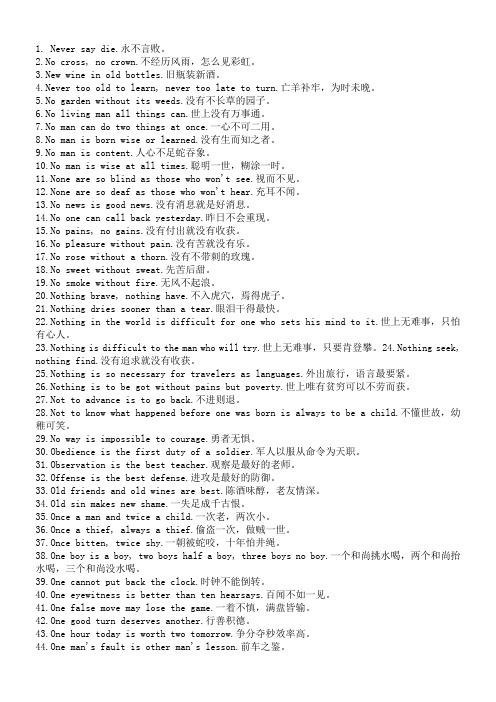
1. Never say die.永不言败。
2.No cross, no crown.不经历风雨,怎么见彩虹。
3.New wine in old bottles.旧瓶装新酒。
4.Never too old to learn, never too late to turn.亡羊补牢,为时未晚。
5.No garden without its weeds.没有不长草的园子。
6.No living man all things can.世上没有万事通。
7.No man can do two things at once.一心不可二用。
8.No man is born wise or learned.没有生而知之者。
9.No man is content.人心不足蛇吞象。
10.No man is wise at all times.聪明一世,糊涂一时。
11.None are so blind as those who won't see.视而不见。
12.None are so deaf as those who won't hear.充耳不闻。
13.No news is good news.没有消息就是好消息。
14.No one can call back yesterday.昨日不会重现。
15.No pains, no gains.没有付出就没有收获。
16.No pleasure without pain.没有苦就没有乐。
17.No rose without a thorn.没有不带刺的玫瑰。
18.No sweet without sweat.先苦后甜。
19.No smoke without fire.无风不起浪。
20.Nothing brave, nothing have.不入虎穴,焉得虎子。
21.Nothing dries sooner than a tear.眼泪干得最快。
22.Nothing in the world is difficult for one who sets his mind to it.世上无难事,只怕有心人。
英语谚语带翻译的
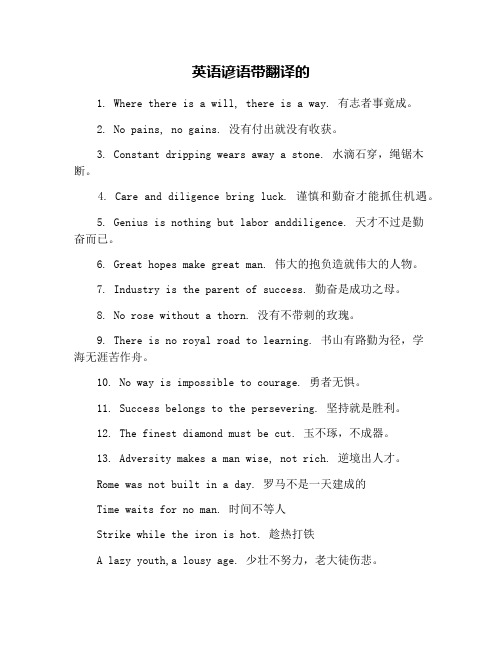
英语谚语带翻译的1. Where there is a will, there is a way. 有志者事竟成。
2. No pains, no gains. 没有付出就没有收获。
3. Constant dripping wears away a stone. 水滴石穿,绳锯木断。
4. Care and diligence bring luck. 谨慎和勤奋才能抓住机遇。
5. Genius is nothing but labor anddiligence. 天才不过是勤奋而已。
6. Great hopes make great man. 伟大的抱负造就伟大的人物。
7. Industry is the parent of success. 勤奋是成功之母。
8. No rose without a thorn. 没有不带刺的玫瑰。
9. There is no royal road to learning. 书山有路勤为径,学海无涯苦作舟。
10. No way is impossible to courage. 勇者无惧。
11. Success belongs to the persevering. 坚持就是胜利。
12. The finest diamond must be cut. 玉不琢,不成器。
13. Adversity makes a man wise, not rich. 逆境出人才。
Rome was not built in a day. 罗马不是一天建成的Time waits for no man. 时间不等人Strike while the iron is hot. 趁热打铁A lazy youth,a lousy age. 少壮不努力,老大徒伤悲。
英语谚语及翻译
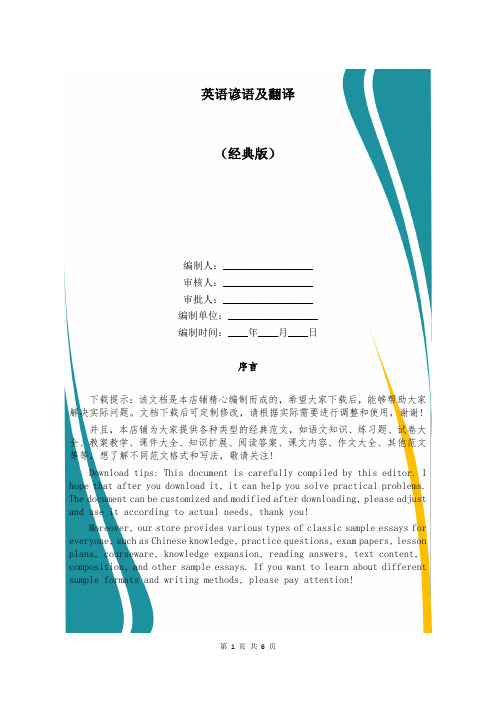
英语谚语及翻译(经典版)编制人:__________________审核人:__________________审批人:__________________编制单位:__________________编制时间:____年____月____日序言下载提示:该文档是本店铺精心编制而成的,希望大家下载后,能够帮助大家解决实际问题。
文档下载后可定制修改,请根据实际需要进行调整和使用,谢谢!并且,本店铺为大家提供各种类型的经典范文,如语文知识、练习题、试卷大全、教案教学、课件大全、知识扩展、阅读答案、课文内容、作文大全、其他范文等等,想了解不同范文格式和写法,敬请关注!Download tips: This document is carefully compiled by this editor. I hope that after you download it, it can help you solve practical problems. The document can be customized and modified after downloading, please adjust and use it according to actual needs, thank you!Moreover, our store provides various types of classic sample essays for everyone, such as Chinese knowledge, practice questions, exam papers, lesson plans, courseware, knowledge expansion, reading answers, text content, composition, and other sample essays. If you want to learn about different sample formats and writing methods, please pay attention!英语谚语及翻译1、A man is never too old to learn.活到老,学到老。
国风谚语英文
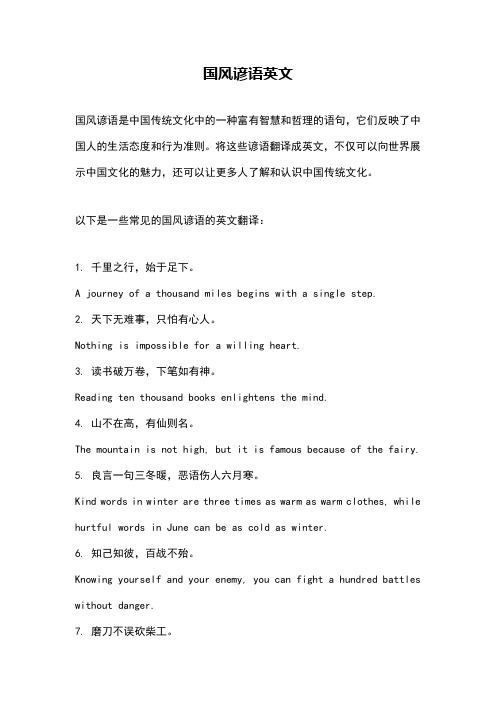
国风谚语英文国风谚语是中国传统文化中的一种富有智慧和哲理的语句,它们反映了中国人的生活态度和行为准则。
将这些谚语翻译成英文,不仅可以向世界展示中国文化的魅力,还可以让更多人了解和认识中国传统文化。
以下是一些常见的国风谚语的英文翻译:1. 千里之行,始于足下。
A journey of a thousand miles begins with a single step.2. 天下无难事,只怕有心人。
Nothing is impossible for a willing heart.3. 读书破万卷,下笔如有神。
Reading ten thousand books enlightens the mind.4. 山不在高,有仙则名。
The mountain is not high, but it is famous because of the fairy.5. 良言一句三冬暖,恶语伤人六月寒。
Kind words in winter are three times as warm as warm clothes, while hurtful words in June can be as cold as winter.6. 知己知彼,百战不殆。
Knowing yourself and your enemy, you can fight a hundred battles without danger.7. 磨刀不误砍柴工。
Practicing your skills does not delay your work.8. 近朱者赤,近墨者黑。
Beware of the company you keep.9. 人生得意须尽欢,莫使金樽空对月。
Enjoy life while you have it, do not let your golden cup empty in front of the moon.10. 知之为知之,不知为不知,是知也。
中国谚语的英语翻译
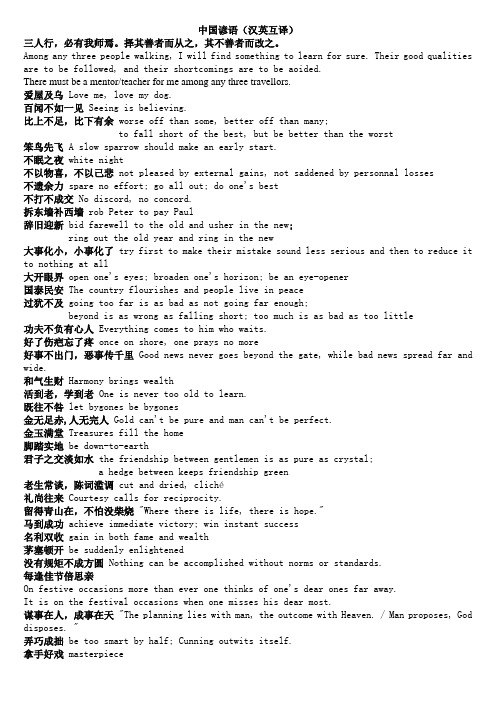
中国谚语(汉英互译)三人行,必有我师焉。
择其善者而从之,其不善者而改之。
Among any three people walking, I will find something to learn for sure. Their good qualities are to be followed, and their shortcomings are to be aoided.There must be a mentor/teacher for me among any three travellors.爱屋及乌Love me, love my dog.百闻不如一见 Seeing is believing.比上不足,比下有余 worse off than some, better off than many;to fall short of the best, but be better than the worst笨鸟先飞 A slow sparrow should make an early start.不眠之夜 white night不以物喜,不以己悲 not pleased by external gains, not saddened by personnal losses不遗余力 spare no effort; go all out; do one's best不打不成交 No discord, no concord.拆东墙补西墙 rob Peter to pay Paul辞旧迎新bid farewell to the old and usher in the new;ring out the old year and ring in the new大事化小,小事化了 try first to make their mistake sound less serious and then to reduce itto nothing at all大开眼界 open one's eyes; broaden one's horizon; be an eye-opener国泰民安 The country flourishes and people live in peace过犹不及 going too far is as bad as not going far enough;beyond is as wrong as falling short; too much is as bad as too little功夫不负有心人 Everything comes to him who waits.好了伤疤忘了疼 once on shore, one prays no more好事不出门,恶事传千里 Good news never goes beyond the gate, while bad news spread far and wide.和气生财 Harmony brings wealth活到老,学到老 One is never too old to learn.既往不咎 let bygones be bygones金无足赤,人无完人 Gold can't be pure and man can't be perfect.金玉满堂Treasures fill the home脚踏实地 be down-to-earth君子之交淡如水 the friendship between gentlemen is as pure as crystal;a hedge between keeps friendship green老生常谈,陈词滥调cut and dried, cliché礼尚往来 Courtesy calls for reciprocity.留得青山在,不怕没柴烧"Where there is life, there is hope."马到成功 achieve immediate victory; win instant success名利双收 gain in both fame and wealth茅塞顿开 be suddenly enlightened没有规矩不成方圆 Nothing can be accomplished without norms or standards.每逢佳节倍思亲On festive occasions more than ever one thinks of one's dear ones far away.It is on the festival occasions when one misses his dear most.谋事在人,成事在天 "The planning lies with man, the outcome with Heaven. / Man proposes, God disposes. "弄巧成拙 be too smart by half; Cunning outwits itself.拿手好戏 masterpiece赔了夫人又折兵 throw good money after bad抛砖引玉 a modest spur to induce others to come forward with valuable contributions;破釜沉舟 cut off all means of retreat;burn one‘s own way of retreat and be determined to fight to the end抢得先机 take the preemptive opportunities巧妇难为无米之炊 If you have no hand you can't make a fist./One can't make bricks without straw.千里之行始于足下a thousand-li journey begins with the first step--the highest eminence is to be gained step by step前事不忘,后事之师 Past experience, if not forgotten, is a guide for the future.前人栽树,后人乘凉 One generation plants the trees in whose shade another generation rests. One sows and another reaps.前怕狼,后怕虎 fear the wolf in front and the tiger behind/ hesitate in doing something强龙难压地头蛇 Even a dragon (from the outside) finds it hard to control a snake in its old haunt - Powerful outsiders can hardly afford to neglect local bullies.强强联手 win-win co-operation瑞雪兆丰年 A timely snow promises a good harvest.人之初,性本善 Man's nature at birth is good.人逢喜事精神爽Joy puts heart into a man.人海战术 huge-crowd strategy世上无难事,只要肯攀登 "Where there is a will, there is a way. "世外桃源 a fictitious land of peace away from the turmoil of the world;死而后已 until my heart stops beating岁岁平安 Peace all year round上有天堂,下有苏杭 "Just as there is paradise in heaven, ther are Suzhou and Hangzhou on earth." 塞翁失马,焉知非福 Misfortune may be an actual blessing.三十而立 "A man should be independent at the age of thirty.At thirty, a man should be able to think for himself."升级换代 updating and upgrading (of products)四十不惑 Life begins at forty.谁言寸草心,报得三春晖 "Such kindness of warm sun, can't be repaid by grass. "水涨船高 When the river rises, the boat floats high.时不我待 Time and tide wait for no man.杀鸡用牛刀 break a butterfly on the wheel实事求是 seek truth from facts; be practical and realistic; be true to facts说曹操,曹操到 Talk of the devil and he comes.实话实说 speak the plain truth; call a spade a spade; tell it as it is实践是检验真理的唯一标准 Practice is the sole criterion for testing truth.山不在高,有仙则名 "No matter how high the mountain is, its name will spread far and wide if there is a fairy; "韬光养晦 hide one's capacities and bide one's time糖衣炮弹 sugar-coated bullets天有不测风云 Anything unexpected may happen. a bolt from the blue团结就是力量 Unity is strength.“跳进黄河洗不清” "eve if one jumped into the Yellow River, one can not wash oneselfclean--there's nothing one can do to clear one's name "歪风邪气 unhealthy practices and evil phenomena物以类聚,人以群分 Birds of a feather flock together.往事如风 "The past has vanished (from memory) like wind.; What in past, is past."望子成龙 hold high hopes for one's child屋漏又逢连阴雨 Misfortunes never come singly. When it rains it pours.文韬武略 military expertise; military strategy唯利是图 draw water to one's mill无源之水,无本之木 water without a source, and a tree wiithout roots无中生有 make/create something out of nothing无风不起浪 There are no waves without wind. There's no smoke without fire.徇私枉法 bend the law for the benefit of relatives or friends新官上任三把火 a new broom sweeps clean虚心使人进步,骄傲使人落后 Modesty helps one go forward, whereas conceit makes one lag behind. 蓄势而发 accumulate strength for a take-off心想事成 May all your wish come true心照不宣 have a tacit understanding; give tacit consent; tacit understanding先入为主 First impressions are firmly entrenched.先下手为强 catch the ball before the bound像热锅上的蚂蚁 like an ant on a hot pan现身说法 warn people by taking oneself as an example息事宁人 pour oil on troubled waters喜忧参半 mingled hope and fear循序渐进 step by step一路平安,一路顺风 speed somebody on their way; speed the parting guest严以律己,宽以待人 be strict with oneself and lenient towards others鱼米之乡 a land of milk and honey有情人终成眷属"Jack shall have Jill, all shall be well."有钱能使鬼推磨 Money makes the mare go. Money talks.有识之士 people of vision有勇无谋 use brawn rather than brain有缘千里来相会 Separated as we are thousands of miles apart, we come together as if by predestination.与时俱进 advance with times以人为本 people oriented; people foremost因材施教 teach students according to their aptitude欲穷千里目,更上一层楼 "to ascend another storey to see a thousand miles further; Ascend further, were you to look farther; Would eye embrace a thousand miles? Go up, one flight."欲速则不达 Haste does not bring success.优胜劣汰survival of the fittest英雄所见略同 Great minds think alike.冤家宜解不宜结 Better make friends than make enemies.冤假错案 "cases in which people were unjustly, falsely or wrongly charged or sentenced; unjust, false or wrong cases"一言既出,驷马难追 A real man never goes back on his words.招财进宝 Money and treasures will be plentiful债台高筑 become debt-ridden致命要害 Achilles' heel众矢之的 target of public criticism知己知彼,百战不殆 Know the enemy and know yourself, and you can fight a hundred battles with no danger of defeat.纸上谈兵 be an armchair strategist纸包不住火 Truth will come to light sooner or later.左右为难 between the devil and the deep blue sea; between the rock and the hard place永远不要因为害怕三振出局而退出比赛Never let the fear of striking out keep you from playing the game.。
常见中国谚语英文翻译
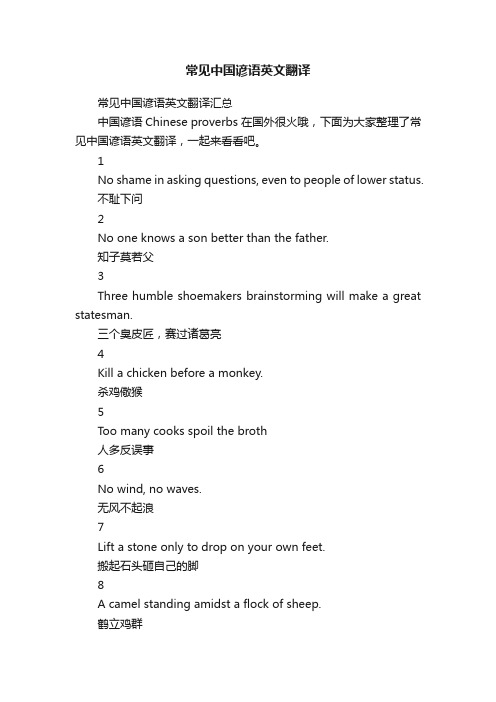
常见中国谚语英文翻译常见中国谚语英文翻译汇总中国谚语Chinese proverbs 在国外很火哦,下面为大家整理了常见中国谚语英文翻译,一起来看看吧。
1No shame in asking questions, even to people of lower status.不耻下问2No one knows a son better than the father.知子莫若父3Three humble shoemakers brainstorming will make a great statesman.三个臭皮匠,赛过诸葛亮4Kill a chicken before a monkey.杀鸡儆猴5Too many cooks spoil the broth人多反误事6No wind, no waves.无风不起浪7Lift a stone only to drop on your own feet.搬起石头砸自己的脚8A camel standing amidst a flock of sheep.鹤立鸡群9An inch of time is an inch of gold but you can't buy that inch of time with an inch of gold.一寸光阴一寸金,寸金难买寸光阴。
10Only when all contribute their firewood can they build up a strong fire.众人拾柴火焰高11An ant may well destroy a whole dam.千里之堤毁于蚁穴12Clear conscience never fears midnight knocking.不做亏心事,不怕鬼敲门13One cannot refuse to eat just because there is a chance of being choked.因噎废食14If a son is uneducated, his dad is to blame.子不教,父之过15A closed mind is like a closed book; just a block of wood.呆若木鸡16When you are poor, neighbors close by will not come; once you become rich, you'll be surprised by visits from (alleged) relatives afar.穷在闹市无人问,富在深山有远亲。
常见50个谚语英文翻译

1.the water that bears the boat is the same that swallows it up.水能载舟,亦能覆舟。
2.observation is the best teacher.观察是最好的老师。
3.offense is the best defense.进攻是最好的防御。
4.old friends and old wines are best.东酒味醇,老友情深。
5.old sin makes new shame.一失足成千古恨。
6.once a man and twice a child.一次老,两次小。
7.once a thief,always a thief.偷盗一次,做贼一世。
8.once bitten,twice shy.一朝被蛇咬,十年怕井绳。
9.one boy is a boy,two boys half a boy,three boys no boy.一个和尚挑水喝,两个和尚抬水喝,三个和尚没水喝。
10.wet behind the ears.乳臭未干。
11.one cannot put back the clock.时钟不能倒转。
12.one eyewitness is better than ten hearsays.百闻不如一见。
13.one false move may lose the game.-着不慎,满盘皆输。
14.one good turn deserves another.行善积德。
15.one hour today is worth two tomorrow.争分夺秒效率高。
16.one man's fault is other man's lesson.前车之鉴。
17.one never loses anything by politeness.讲礼貌不吃亏。
18.one swallow does not make a summ一燕不成夏。
(完整版)谚语翻译

Pull yourself up by your bootstraps, and No
凭自身的力里重新振作起来;
pain, no gain.
一分耕耘一分收获。/不吃苦,无收获。
5. A man's home is his castle.
5、家是一个人的城堡。/金窝银窝不如自
家的狗窝。
The spit aimed at the sky comes back to one.
Kick a stone in an ger and harm your ownபைடு நூலகம்foot.
17.Sweep only in front of your own door.
He who stirs another'porridge often bur ns his own.
言。
不入虎穴,焉得虎子。
3. Man does not live by bread alone and
3、a.人不是只为面包而活着;
Make hay while the sun shin es.
b.趁热晒草,勿失良辰。
/乘机行事,抓紧时机。
4. God helps those who help themselves,
6. The squeaky wheel gets the grease.
6、会哭的孩子有奶吃。
7. Variety is the spice of life, Light ning n ever
7、多样化是生活的调味品;
strikes twice in the same place, and There is
11、愈挫愈勇。
12. A man's tongue is his sword.
经典英文谚语及中文翻译
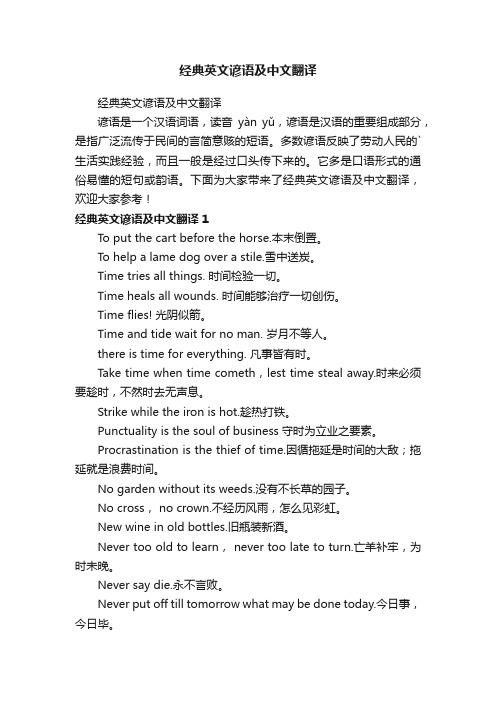
经典英文谚语及中文翻译经典英文谚语及中文翻译谚语是一个汉语词语,读音yàn yǔ,谚语是汉语的重要组成部分,是指广泛流传于民间的言简意赅的短语。
多数谚语反映了劳动人民的`生活实践经验,而且一般是经过口头传下来的。
它多是口语形式的通俗易懂的短句或韵语。
下面为大家带来了经典英文谚语及中文翻译,欢迎大家参考!经典英文谚语及中文翻译1To put the cart before the horse.本末倒置。
To help a lame dog over a stile.雪中送炭。
Time tries all things. 时间检验一切。
Time heals all wounds. 时间能够治疗一切创伤。
Time flies! 光阴似箭。
Time and tide wait for no man. 岁月不等人。
there is time for everything. 凡事皆有时。
Take time when time cometh,lest time steal away.时来必须要趁时,不然时去无声息。
Strike while the iron is hot.趁热打铁。
Punctuality is the soul of business守时为立业之要素。
Procrastination is the thief of time.因循拖延是时间的大敌;拖延就是浪费时间。
No garden without its weeds.没有不长草的园子。
No cross, no crown.不经历风雨,怎么见彩虹。
New wine in old bottles.旧瓶装新酒。
Never too old to learn, never too late to turn.亡羊补牢,为时未晚。
Never say die.永不言败。
Never put off till tomorrow what may be done today.今日事,今日毕。
传统谚语的英文翻译
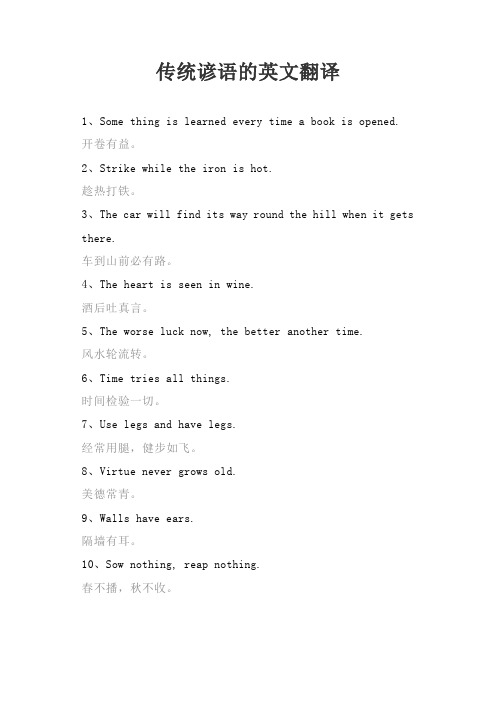
传统谚语的英文翻译1、Some thing is learned every time a book is opened.开卷有益。
2、Strike while the iron is hot.趁热打铁。
3、The car will find its way round the hill when it gets there.车到山前必有路。
4、The heart is seen in wine.酒后吐真言。
5、The worse luck now, the better another time.风水轮流转。
6、Time tries all things.时间检验一切。
7、Use legs and have legs.经常用腿,健步如飞。
8、Virtue never grows old.美德常青。
9、Walls have ears.隔墙有耳。
10、Sow nothing, reap nothing.春不播,秋不收。
11、Life is real, life is earnest.人生真实,人生诚挚。
12、Life would be too smooth if it had no rubs in it.生活若无波折险阻,就会过于平淡无奇。
13、Life is the art of drawing sufficient conclusions form insufficient premises.生活是一种艺术,要在不充足的前提下得出充足的结论。
14、Life is fine and enjoyable, yet you must learn to enjoy your fine life.人生是美好的,但要学会如何享用美好的生活。
15、Life is but a hard and tortuous journey.人生即是一段艰难曲折的旅程,人生无坦途。
16、Life is a horse, and either you ride it or it rides you.人生像一匹马,你不驾驭它,它便驾驭你。
英文谚语及翻译
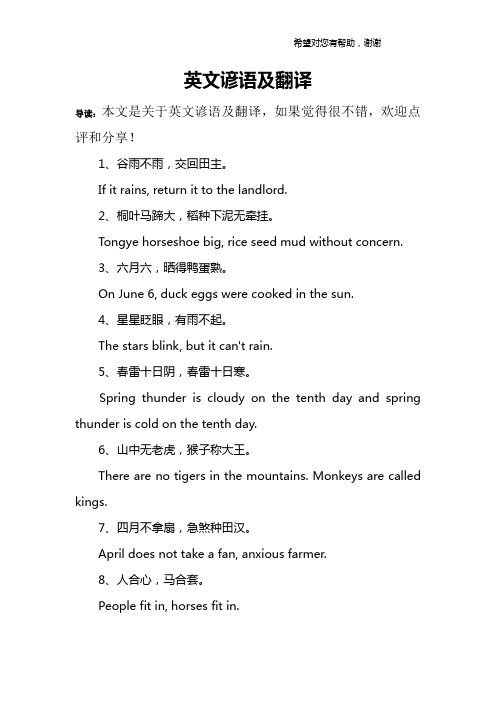
英文谚语及翻译导读:本文是关于英文谚语及翻译,如果觉得很不错,欢迎点评和分享!1、谷雨不雨,交回田主。
If it rains, return it to the landlord.2、桐叶马蹄大,稻种下泥无牵挂。
Tongye horseshoe big, rice seed mud without concern.3、六月六,晒得鸭蛋熟。
On June 6, duck eggs were cooked in the sun.4、星星眨眼,有雨不起。
The stars blink, but it can't rain.5、春雷十日阴,春雷十日寒。
Spring thunder is cloudy on the tenth day and spring thunder is cold on the tenth day.6、山中无老虎,猴子称大王。
There are no tigers in the mountains. Monkeys are called kings.7、四月不拿扇,急煞种田汉。
April does not take a fan, anxious farmer.8、人合心,马合套。
People fit in, horses fit in.9、水多成河,粪多成禾。
More water makes rivers, more feces make grains.10、柱石脚下潮有雨。
At the foot of the pillars there was rain and tide.11、病来如山倒,病去如抽丝。
Diseases come down like mountains and go away like threads.12、走的多了成道路,吃的多了成习惯。
The more you walk, the more you eat, the more you become a habit.13、右是目,左是眼。
常用英语谚语30条简短带翻译
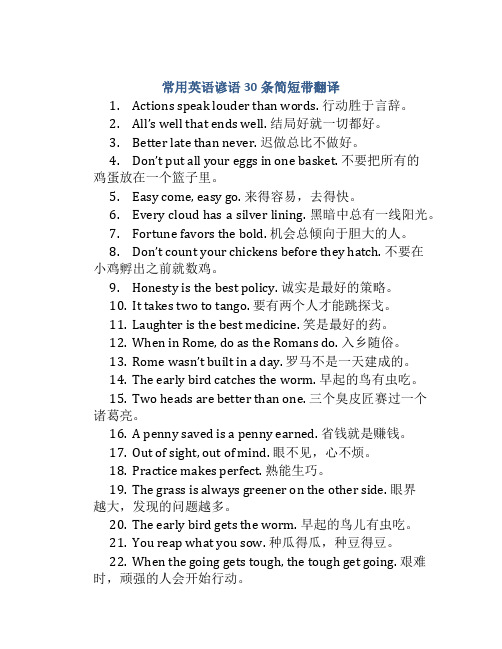
常用英语谚语30条简短带翻译1.Actions speak louder than words. 行动胜于言辞。
2.All’s well that ends well. 结局好就一切都好。
3.Better late than never. 迟做总比不做好。
4.Don’t put all your eggs in one basket. 不要把所有的鸡蛋放在一个篮子里。
5.Easy come, easy go. 来得容易,去得快。
6.Every cloud has a silver lining. 黑暗中总有一线阳光。
7.Fortune favors the bold. 机会总倾向于胆大的人。
8.Don’t count your chickens before they hatch. 不要在小鸡孵出之前就数鸡。
9.Honesty is the best policy. 诚实是最好的策略。
10.It takes two to tango. 要有两个人才能跳探戈。
ughter is the best medicine. 笑是最好的药。
12.When in Rome, do as the Romans do. 入乡随俗。
13.Rome w asn’t built in a day. 罗马不是一天建成的。
14.The early bird catches the worm. 早起的鸟有虫吃。
15.Two heads are better than one. 三个臭皮匠赛过一个诸葛亮。
16.A penny saved is a penny earned. 省钱就是赚钱。
17.Out of sight, out of mind. 眼不见,心不烦。
18.Practice makes perfect. 熟能生巧。
19.The grass is always greener on the other side. 眼界越大,发现的问题越多。
中国经典谚语英语翻译

中国经典谚语英语翻译导读:本文是关于中国经典谚语英语翻译,如果觉得很不错,欢迎点评和分享!1、你敬人一尺,人敬你一丈。
You respect people one foot, people respect you one foot.2、年纪不饶人,节令不饶天。
Age does not spare people, season does not spare days.3、粗丝难织细绢,粗人难做细活。
It is difficult for coarse silk to weave fine silk and for rough people to do fine work.4、船载千斤,掌舵一人。
Shipborne jacks, one man at the helm.5、吃饭吃米,说话说理。
Eat rice for dinner and make sense.6、好种出好苗,好树结好桃。
Good planting, good seedling, good tree, good peach.7、尺有所短,寸有所长。
The ruler is short and the inch is long.8、关西出将,关东出相。
Guanxi is a general and Guandong is a minister.9、从俭入奢易,从奢入俭难。
From thrift to luxury is easy, from luxury to frugality is difficult.10、撑死胆大的人,饿死胆小的鬼。
Supports the bold person, starves the cowardly ghost.11、狗朝屁走,人朝势走。
Dogs go fart, people go at the trend.12、话不要说死,路不要走绝。
Don't talk to death, don't walk all the way.13、会过不会过,少养张口货。
常用谚语英文翻译

常用谚语英文翻译导读:1、水浸千年松,日晒万年樟。
Millennium pine soaked in water and sunbathed in camphor for ten thousand years.2、冰冻三尺,非一日之寒。
Freezing three feet is not a day's cold.3、与其坐而言,不如起而行。
It's better to go up than sit down.4、贪吃贪睡,添病减岁。
Gluttony and sleepiness make you sick and younger.5、冬练三九,夏练三伏。
Practice 39 volts in winter and 3 volts in summer.6、不做亏心事,哪怕半夜鬼叫门。
Don't feel guilty, even if ghosts call in the middle of the night.7、路在人走,事在人为。
The road is man-made.8、财多祸身,欲多伤神。
Wealth is bad, but desire is bad.9、门内有君子,门外君子至。
There are gentlemen in the door and gentlemen outside.10、不随地吐痰。
Don't spit everywhere.11、病好不谢医,天下无人医。
No one in the world can thank the doctor for his illness.12、晨日照云间,午后起风暴。
In the morning the clouds shine, and in the afternoon the storm rises.13、大蒜是个宝,常吃身体好。
Garlic is a treasure. It is always good to eat.14、人不可貌相,海水不能用斗量。
中国谚语的英文翻译

中国谚语的英文翻译1.见机行事。
1. Act according to circumstances.2.兵不厌诈。
2. All is fair in war.3.留得青山在,不怕没柴烧。
3. As long as the green hills last, there'll always be wood to burn.4.种瓜得瓜,种豆得豆。
4. As you sow, so shall you reap.5.不问就听不到假话。
5. Ask no questions and be told no lies.6.情人眼里出西施。
6. Beauty lies in lover's eye7.血浓于水。
7. Blood is thicker than water.8.海内存知己,天涯假设比邻。
8. A bosom friend afar brings a distant land near 9.简洁是智慧的灵魂。
9. Brevity is the soul of wit.10.公事公办。
10.Business is business.11.车到山前必有路。
11.The cart will find its way round the hill ,when it gets there. 12.巧妇难为无米之炊。
12. he cleverest housewife cannot cook a meal without rice. 13.笨鸟先飞。
13. Clumsy birds have to start flying early.14.精诚所至,金石为开。
14. Complete sincerity can affect even metal and stone.15.置之死地而后生。
15. Confront a person with the danger of death and he will fight to live.16.滴水穿石。
- 1、下载文档前请自行甄别文档内容的完整性,平台不提供额外的编辑、内容补充、找答案等附加服务。
- 2、"仅部分预览"的文档,不可在线预览部分如存在完整性等问题,可反馈申请退款(可完整预览的文档不适用该条件!)。
- 3、如文档侵犯您的权益,请联系客服反馈,我们会尽快为您处理(人工客服工作时间:9:00-18:30)。
(1). Phonetic Features (语音特点)
谚语内容深刻,形式优美,在语音上,往往语音 铿锵,朗朗上口,音调和谐,节奏鲜明。
A. 汉语谚语:语音和谐动听,表现在平仄和押 韵。 a. 一年之计在于春,一日之计在于晨。 b. 处事莫烦恼,烦恼容易老。 c. 山清水秀,百姓长寿。 d. 邻居好,无价宝。
d. Spare the rod and spoil the child. 省了棍棒,却宠坏了孩子。 e. Ready money is ready medicine. 现成的钱是现成的药。(有钱好办事)
(2). Semantic Features(语义特点)
A. 历史联系意义 a. 宁为鸡首,不为牛后(宁为鸡口,毋为牛后) Better be a bird’s beak than a cow’s rump b. It is better to reign in hell than serve in heaven. 宁可在地狱称王,也不在天堂为奴。 B. 词的潜在意义 汉英许多谚语中均使用了形象比喻。 a. 树叶落下来怕打破头。 b. He dare not say “Boo” to a goose. 在鹅面前也不敢“呸”一声。
B. 英语谚语 a. Living without the aim is like sailing without a compass . 生活没有目标,犹如航海中没有罗盘 b.Everybody’s business is nobody’s busines. 三个和尚没水喝 c. Good wine needs no bush. 酒香不怕巷子深
(3). Every man must bear his own cross. 人人都得背自己的十字架。 (4). God helps those who help themselves 天助自主者 。
4. Methods to Translate Proverbs (翻译方法 翻译方法) 翻译方法 1). Literal Translation 直译法 在不违背译文语言规范以及不引起错误联 想的条件下,在译文中保留英语谚语的比喻形 象和民族、地方色彩的方法。 A. 英语谚语 英语谚语: (1). Forbidden fruit is sweet 禁果分外甜 (2. Art is long, life is short 生命短暂,艺术永恒 (拉丁语)
B. 人名的使用 a. 借酒浇愁,惟有杜康。 b. 姜太公钓鱼,愿者上钩。 c. Even Homer sometimes nods. 就连荷马有时也会弄错。 (智者千虑,必有一失) d. Every Jack has his Jill. 每个杰克都有他的吉尔。 (情人眼里出美女)
(4). Grammatical Features (语法特点)
3). 来自宗教信仰 A. 汉语谚语 (1)出家容易归家难。 (2)平时不烧香,临时抱佛脚。 (3)三个和尚没水喝。 (4) 信言不美,美言不信(《道德经》) (5)知者不言,言者不知。(知北游》庄子) B. 英语谚语 (1).Christmas comes but one year. 圣诞节一年才过一次,或佳节难逢
b). Elliptical sentences No cross, no crown 没有十字架,没有王冠 (吃尽苦中苦,方为人上人) c). Complex sentences He is lifeless that is faultless. 不犯错误的人是没有生命的人。 (人非圣贤,熟能无过)
注:谚语“Christmas comes but one year(圣诞节一年 才过一次,或佳节难逢)”已成为人们耳熟能详的一句 话。圣诞节是基督教国家最盛大的节日,具有独特的 宗教文化蕴义。节日期间,人们常用此谚语劝人们对 别人的吵闹和大吃大喝要忍着点,不要太在意;同时 也劝谕人们把握机会,送送东西或帮助穷困的人,行救 困济贫之善举。 (2). Merry in Lent,and you’ll live to repent. 四旬斋结婚,悔恨终生 (这一说法源于四旬斋(Lent)这一宗教节日:节日期间, 基督教徒素食苦行,把斋期当作赎罪的神圣日子,因此 人们认为斋期会给人带来厄运。)
C)源于《伊索寓言》 )源于《伊索寓言》 (1).The grapes are sour 。吃不到葡萄就说葡萄是 酸的。 (2).A dog in manger. 站着茅坑不拉屎。(在其位者不谋其政) (3).Blow hot and cold . 朝三暮四。 D)源自希腊和罗马神话 ) (1).The Devil too has Achilles’ heel 魔鬼也有阿契里斯的脚跟
B. 英语谚语:除押韵外,尚有元音重复(assonance),
音节尾的辅音重复(consonance)和音节的头一个 音重复(alliteration)
a. Eat an apple going to bed, make the doctor beg his bread. 睡觉前吃一个苹果,医生就只好去乞讨。 b. No pains, no gains. 不劳不获。 c. Stuff a cold and starve a fever. 喂感冒,饿发烧。
2). 源自文学作品和文化典籍 A. 汉语谚语 (1). 人以类聚,物以群分(《周易》) (2). 他山之石,可以攻玉(《诗经》) (3). 小不忍则乱大谋(《论语》) (4). 万事俱备,只欠东风(《三国演义》) B. 英语谚语
(1)来源于莎士比亚的作品 )
(1). Murder will out. 纸包不住火。 (2). Strange bedfellows. 同床异梦。 (3).All is not gold that glitter. 闪光的东西并不都是黄金 ( This proverb is fromShakespeare’s The Merchants of Venice . It shows us that those who have a good appearance are not really learned. So we should be careful not to be deceived by those who are superficially flashy but without substance. 这个谚语来自莎士比亚的《威尼斯商人》。它向我 们表明,那些有美丽的外表的人并不都是有真才实学 的。所以我们应该小心不要被那些表面华丽,但是没 有实质的事物的骗了。)
3. Sources of Proverbs (谚语的来源) 谚语的来源) 谚语的来源 1)、源自民间口语 、 A. 汉语谚语 a. 人多出圣人 b. 机不可失,时不再来 (When an opportunity is neglected it never comes back to you.) c. 在家千日好,出门处处难。(There is no place like home) d. 麦黄不收,有粮也丢。
C). 比较选择关系
a. 真穷好过,假富难挨。 b. 一事全知,胜过万事半知。 c. Better a little loss than a long sorrow. 长痛不如短痛。
D). 直接指导关系
a. Beat the dog before the lion. 在狮子面前打狗(吧)。 (杀鸡吓猴,杀一儆百) b. Do not hold a candle to the devil 不要给魔鬼照蜡烛 ( 不要助纣为虐) c. Never put off till tomorrow that you can do today. 你今天能做的事决不拖到明天。 (今日事,今日毕)
(3). Lexical Feபைடு நூலகம்tures (词汇特点)
A. 数词的使用
a. 一山不容二虎 (One bad general is better than two good generals) b. One swallow does not make a summer. 一只燕子形不成夏天。 c. It takes two to make a quarrel. 两个人才吵得起来。 (一个巴掌拍不响)
(3). A home without love is no more than a baby without a soul. 没有爱的家庭就像一个没有灵魂的躯体 。 (4). Life is short and time is swift. 人生苦短,岁月易逝。 (5). New-born calves make little of tigers 初生牛犊不怕虎
谚语句式固定,结构精练,格式对称,音节整齐,语 调和谐。
A. 汉语谚语 a). 三三式 人争气,火争焰。 努力干,没寒酸。 b). 四四式 不上高山,不显平地。 病从口入,祸从口出。
c). 五五式 火车跑得快,全靠车头带。 B. 英语谚语 a). Simple sentences Many hands make light work. 人多好办事。 No herb will cure love. 心病还需心药医。
谚语是人民群众口头流传的习用的固定语 句,用简单通俗的话来反映深刻的道理。 谚语是民间集体创造、广为口传、言简意 赅并较为定型的艺术语句,是民众丰富智 慧和普遍经验的规律性总结。
2). Features (特点) 特点) 特点 (1). Phonetic Features (语音特点) (2). Semantic Features(语义特点) (3). Lexical Features(词汇特点) (4). Syntactic Features(语法特点)
C. 语义关系
A). 对等关系 正负两种形式,A是B,A不是B。 a. 一寸光阴一寸金,寸金难买寸光阴。 b. Time is money. 时间就是金钱。 c. Boys will be men. 小孩终归会长大成人。 B). 因果关系 a. 鸡蛋不破,苍蝇不叮。
